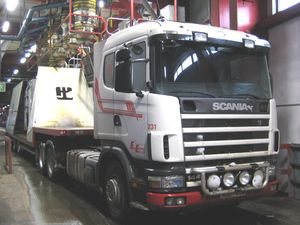Höganäs AB, a Swedish producer of metal powders used to make engines, drive systems and tools, is using a infrared auto-identification system to track containers filled with metal powders at its factory in the city of Höganäs. Instead of transmitting data by means of radio waves, as RFID systems do, IRID tags and readers transmit using infrared signals. Swedish passive infrared identification system developer Scirocco provided the system, dubbed IRID for infrared identification (see Sound and Light).
To better control its production process, Höganäs had wanted an overview of which metal powders are at what stages of production. It had been using an RFID system to identify containers, but it faced several problems with RFID. For instance, Höganäs was using a system with a low read range because that was what was available at the time of installation many years ago. Occasionally drivers miscalculated and ran their trucks into readers, and replacing the parts was difficult. In addition, the metal environment of the factory caused RF interference—that is, it was hard to set the tags at the right distance from readers.
When Höganäs decided to replace its older RFID system, it considered an RFID platform with a longer read range, as well as bar code technology. It decided against longer-range RFID system because of the risk that an interrogator would capture data from the wrong tag and that multiple interrogators might interfere with one another. Moreover, the price of the RFID system was high in comparison to the 50,000-euro IRID system, which included readers, tags, programmable logic controllers (PLCs) and software. (The PLCs are installed next to the readers and serve several purposes, such as handling the interface with other equipment and visually indicating a container’s ID number.) Höganäs dropped the idea of a bar code system because it feared that airborne metal dust in the factory would quickly coat the bar code labels, making them illegible. Höganäs’ own tests before ordering the system from Scirocco showed that IRID signals, with have a wavelength twice as long as that of visible light, penetrate the metal dust on tags and interrogators without significantly reducing the read range.
Scirocco’s interrogators and tags contain light emitting diodes (LEDs) to generate the IR signals, and photovoltaic cells to receive them. The tags, which can be read and encoded by an interrogator up to 3 meters away, have no battery and are instead powered by an interrogator’s infrared signal. Since infrared waves have controlled propagation characteristics, explains Staffan Sjögren, Scirocco’s managing director, the system’s read/write zone has no dead spots and the zone’s outer borders are sharply defined, reducing the likelihood that IR waves will reflect off surrounding structures and create signal interference. This provides 100 percent read rates inside the zone and zero reads outside of it. The interrogator can even read an IR tag if the line of sight between the tag and reader is partially but not totally obstructed. This limitation does not pose any problems for the Höganäs deployment because the interrogators are positioned to have a clear line of sight with the tags.
The powder maker installed the IRID tracking system in August 2006 on one of its factory lines in Höganäs. It used the system for three months and then expanded it to another production line in December. The company now has tagged 150 metal-powder containers that pass through the two production lines. The rectangular tags, about the size of a credit card, are bolted to a metal girder on the side of the containers. The containers, which are 3 meters tall, have valves to release the powder.
To enable Höganäs to monitor whether the valves are open and closed, Scirocco combined the IRID tags with a passive sensor (powered by the tag) that can determine the position of the switches in the motor-driven valves of the containers. The infrared signals carry the information about the valve’s status together with the container’s identification code. The alphanumeric identification code is programmable locally via the infrared signals. The visual marking on the container can be programmed directly onto the tag, eliminating the need to use cross-reference tables in the middleware.
When containers of unprocessed metal powder arrive by truck, an interrogator mounted at the factory door reads their IRID tags. The containers are then moved along an automated processing line where materials are added to the powder, and the containers are shaken. Each production line has about 10 IRID interrogators, which are mounted at each of the processing stations. The reading distance varies according to the station, but is typically less than 2 meters.
The containers pass through further production steps and are emptied after the IRID interrogator gives the OK to the system to open the valve when the IRID system has registered that the right container has been put in position. The metal powder then passes through a hole in the floor and onto a belt that transports it to furnaces and other processing equipment. At the end of the processing line, the different grades of metal powder arrive in automatic filling stations for loading into strong bags or other containers for shipment to customers.
“The application gives Höganäs control over the logistics in their fully automated yet highly flexible factory and lets them trace production of batches if necessary,” Sjögren says. Although Höganäs declines to disclose what sort of return on investment (ROI) it is getting from the application, Sjögren estimates the company already has attained an ROI.
“Compared to the capital that can be freed up from a processing line of this size by perfect planning and freedom from unintended downtime on the line, the investment cost is a minor expenditure,” Sjögren says. “Further, the traceability that an automatic identification system can offer gives extended possibilities to know which lot of raw material ended up in a certain product for a specific customer.”
Later this year, the company plans to expand the IRID application to its plant in Halmstad, where recycled metal is melted and made into raw powder that is shipped to its factory in Höganäs for processing. IRID interrogators will be used at the Halmstad plant to identify containers being filled with metal powder. This will allow the company to use IRID via a central database to synchronize planning and transportation between the two sites.
Sjögren, who worked many years in RFID R&D for Philips and other companies, founded Scirocco in 1997. Three years ago, he converted the company from a consultancy to one with its own products—the Scirocco IRID system. Scirocco developed IRID after realizing there was a gap in the market for RFID systems with read ranges of 0.5 and 3 meters, especially in applications for factory automation and transportation logistics. Sjögren says that the RFID interrogators for such applications also tend to be too expensive and do not operate well in metal environments.
Scirocco has installed IRID applications in the United States for a number of companies. These firms are using IRID to identify trucks and trailers as they are driven onto truck scales, through entrance gates or to fuel filling stations.




